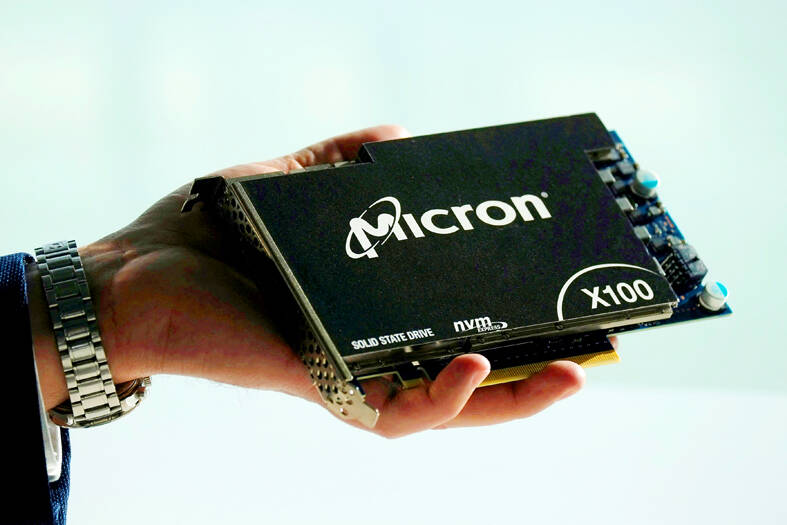Micron Technology Inc, the largest US maker of memory chips, said the worst industry glut in more than a decade would make it difficult to return to profitability next year.
The company on Wednesday announced a host of cost-cutting measures, including a 10 percent workforce reduction, aimed at helping it weather a rapid drop in revenue.
Micron also projected a steep sales decline and a wider loss than analysts had estimated for the current quarter.

Photo: Reuters
The industry is experiencing its worst imbalance between supply and demand in 13 years, Micron chief executive officer Sanjay Mehrotra said.
Inventory should peak in the current period, then decline, he said.
Customers would move to more healthy inventory levels by about the middle of next year, and the chipmaker’s revenue would improve in the second half of the year, Mehrotra said.
“Profitability will be challenged throughout 2023 because of the oversupply that exists in the industry,” he said in an interview. “The rate and pace of the recovery in terms of profitability depends on how fast supply is brought into line.”
Mehrotra said a unique convergence of circumstances — the war in Ukraine, a surge in inflation, COVID-19 and supply disruptions — has thrust the memorychip industry into a repeat of past cycles when prices plummeted and wiped out profits. Micron has responded aggressively to try to quickly get through the difficult period.
Once the downturn is over, the industry would resume profitable growth helped by demand for artificial intelligence computing and automation of various industries, he said.
Micron, which last month said that it was cutting production by about 20 percent, is cutting its budget for new plants and equipment, and now expects to spend from US$7 billion to US$7.5 billion for the fiscal year, a decline from an earlier target of as much as US$12 billion.
The company is slowing the introduction of more advanced manufacturing techniques and predicts that spending on new production will fall throughout the industry.
Micron’s pledge to reduce output from its factories and slow expansion projects would not ease the glut of chips available unless rivals, including Samsung Electronics Co and SK Hynix Inc, follow suit. That step can help support prices, but comes with the penalty of running expensive plants at less than full capacity, something that can weigh heavily on profitability.
In addition to its planned workforce reductions, the company has suspended share repurchases, is cutting executive salaries and would skip company-wide bonus payments, executives said on a conference call after its results were released.
Micron said sales would be about US$3.8 billion in the fiscal second quarter. That compares with analysts’ average estimate of US$3.88 billion, according to data compiled by Bloomberg.
The company projected a loss of about US$0.62 a share, excluding certain items, in the period ending in February, compared with a loss of US$0.29 expected by analysts.
In the three months ended Dec. 1, Micron’s revenue declined 47 percent to US$4.09 billion. The company had a loss of US$0.04 a share, excluding certain items. That compares with an average estimate of a loss of US$0.01 a share on sales of US$4.13 billion.
Micron’s shares declined about 2 percent in extended trading after closing at US$51.19 in New York.
The stock has dropped 45 percent this year, a worst decline than most chip-related equities. The Philadelphia Stock Exchange Semiconductor Index is down 33 percent this year.

Taiwan Semiconductor Manufacturing Co (TSMC, 台積電) has secured three construction permits for its plan to build a state-of-the-art A14 wafer fab in Taichung, and is likely to start construction soon, the Central Taiwan Science Park Bureau said yesterday. Speaking with CNA, Wang Chun-chieh (王俊傑), deputy director general of the science park bureau, said the world’s largest contract chipmaker has received three construction permits — one to build a fab to roll out sophisticated chips, another to build a central utility plant to provide water and electricity for the facility and the other to build three office buildings. With the three permits, TSMC

The DBS Foundation yesterday announced the launch of two flagship programs, “Silver Motion” and “Happier Caregiver, Healthier Seniors,” in partnership with CCILU Ltd, Hondao Senior Citizens’ Welfare Foundation and the Garden of Hope Foundation to help Taiwan face the challenges of a rapidly aging population. The foundation said it would invest S$4.91 million (US$3.8 million) over three years to foster inclusion and resilience in an aging society. “Aging may bring challenges, but it also brings opportunities. With many Asian markets rapidly becoming super-aged, the DBS Foundation is working with a regional ecosystem of like-minded partners across the private, public and people sectors

BREAKTHROUGH TECH: Powertech expects its fan-out PLP system to become mainstream, saying it can offer three-times greater production throughput Chip packaging service provider Powertech Technology Inc (力成科技) plans to more than double its capital expenditures next year to more than NT$40 billion (US$1.31 billion) as demand for its new panel-level packaging (PLP) technology, primarily used in chips for artificial intelligence (AI) applications, has greatly exceeded what it can supply. A significant portion of the budget, about US$1 billion, would be earmarked for fan-out PLP technology, Powertech told investors yesterday. Its heavy investment in fan-out PLP technology over the past 10 years is expected to bear fruit in 2027 after the technology enters volume production, it said, adding that the tech would

RUN IT BACK: A succesful first project working with hyperscalers to design chips encouraged MediaTek to start a second project, aiming to hit stride in 2028 MediaTek Inc (聯發科), the world’s biggest smartphone chip supplier, yesterday said it is engaging a second hyperscaler to help design artificial intelligence (AI) accelerators used in data centers following a similar project expected to generate revenue streams soon. The first AI accelerator project is to bring in US$1 billion revenue next year and several billion US dollars more in 2027, MediaTek chief executive officer Rick Tsai (蔡力行) told a virtual investor conference yesterday. The second AI accelerator project is expected to contribute to revenue beginning in 2028, Tsai said. MediaTek yesterday raised its revenue forecast for the global AI accelerator used